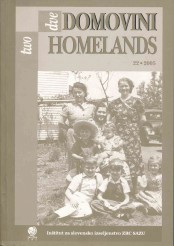MIGRATIONAL SITUATION IN EUROPE AFTER WORLD WAR II AND PROGRESSIVE (POLITICAL) ADJUSTMENTS BETWEEN MEMBER STATES OF THE EUROPEAN UNION
Keywords:
migration Policy, Gemiany, France, Sweden, European UnionAbstract
In the contribution, I am attempting to answer these questions: how was the course of the process of forming a common (compromise) policy on the EU level developing? Which fields of migration policy (in a broader sense) does the EU policy set as mandatory for member states, and which as recommendable only? What are the similarities and differences between selected national migration policies after World War II? Were conformations of separate national policies needed because of agreements on the EU level? Of which, and what were those changes? In my study, I focus on a comparison between Germany, France and Sweden, which were after World War II managing their migration situations by different methods; today they are because of agreements on the EU level, drawing near in certain aspects while the broader migration situation remains in the competence of national policies. In those fields, member states are on the EU level merely conferring on outlines and preferred standpoints that are to be carried into effect in individual (national) migration policies.
Treaties and agreements between EU member states that are adopted and binding on the interstate level are linked above all to the regulation of recent immigration and migration of the population living within individual members states, in the entire EU space. Rights and obligations resulting from those agreements can be divided into three groups: rights of citizens of member states, agreements on inflow of new labour force from non-member states, and (non)rights of the rest of the inhabitants non-citizens. The latter are immigrants who live and work in the EU member states and have not yet acquired citizenship of one of EU member states; thus, they are citizens of non-members of the EU and have permit for staying and for work. The foundations of the Schengen legal order were shaped as early as in the mid eighties. The Maastricht treaty, later supplemented with the Amsterdam one, introduces the right to vote and a number of social rights deriving from labour. The Amsterdam treaty and the European Council in Tampere have given agreements, which demanded from EU member states adjustments in the fields connected with civil rights and national sovereignty. In the EU, there is from the middle of the 90s on, a strong emphasis on the establishing of a common space and thus on a redefinition of borders, and on defining the difference between the so-called internal and external borders. The concept of European citizenship additionally emphasised those differences. Despite uniformity of viewpoints and state strategies of the EU member states in the (im)migration field, key questions on the conditions of the life of immigrants remain on the level of national policies. Historically conditioned differences between member states are still large, although on the other hand we should not overlook changes in individual states that were realised because of the pressures of collective agreements on the EU level.
Downloads
References
Bevc, M., Verlič Christensen., B., Prevolnik Rupel, V. (2000): M igracije v Sloveniji v luči vključitve v EU. Inštitut za ekonomska raziskovanja, Ljubljana.
Bevc, M., Zupančič, J., Lukšič - Hacin, M. (2004): M igracijska politika in problem bega možganov. Inštitut za ekonomska raziskovanja, Ljubljana.
Bešter, R. (2003): M igracijska politika Slovenije in EU. Mirovni inštitut, Ljubljana.
Castles, S., M iller, M. J. (1993, 1998): The Age ofM igration. International Population M ovem ents in the M odem World. M acM illan, London.
Immigrants in Sweden, 1994.
Klinar, P. (1976): M ednarodne migracije. Obzorja, Maribor.
Klinar, P. (1985): M ednarodne migracije v kriznih razm erah. Obzorja, Maribor.
Klinar, P. (1989): Sodobni konjunktivni procesi druge generacije. RONIM ISU, Ljubljana.
Lukšič - Hacin, M. (1995): Ko tujina postane dom. Znanstveno in publicistično središče, Ljubljana.
Lukšič - Hacin, M. (1999): M ultikulturalizem in migracije. Založba ZRC, Ljubljana.
M esić, M., Heršak, E. (1989): Evropa, integracija i (jugoslovenska) migracija. M igracijske teme 1, str. 5-20.
M esit, M. (1993): Strategije razvitih družb. Teorija in praksa 7 -8 , str. 671-674
Verlič Christensen, B. (2000): M igracijska politika Evropske skupnosti in Slovenija. Teorija in praksa 6, str. 1117-1131.
Verlič Christensen, B. (2002): Evropa v precepu med svobodo in omejitvami migracij. Fakulteta za družbene vede, Ljubljana.
Downloads
Published
How to Cite
Issue
Section
License

This work is licensed under a Creative Commons Attribution-NonCommercial-NoDerivatives 4.0 International License.
Authors guarantee that the work is their own original creation and does not infringe any statutory or common-law copyright or any proprietary right of any third party. In case of claims by third parties, authors commit their self to defend the interests of the publisher, and shall cover any potential costs.
More in: Submission chapter





